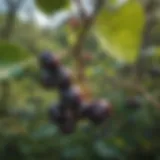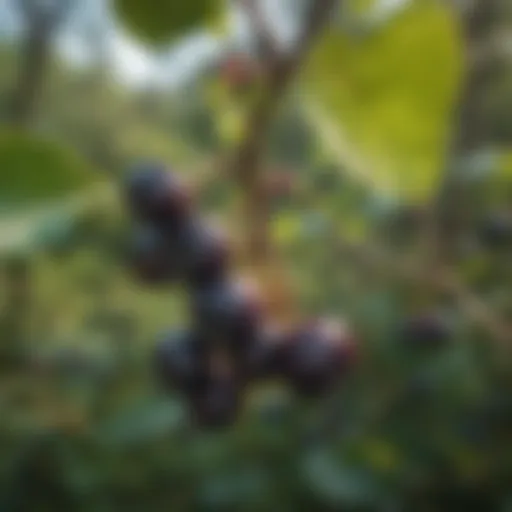Exploring the Intricacies of Oak Tree Leaves


Intro
Oak trees stand as near-iconic figures within American forests, symbolizing strength and endurance. Their leaves not only contribute to the aesthetic richness of the landscape but hold critical insights into their living ecosystem. Understanding oak trees requires delving into various aspects connected with their leaves. This article surveys how different species of oak trees produce distinct foliage characteristics, which serves as a foundation for broader environmental interactions.
As we look closer at the fine details of oak leaves, it’s essential to appreciate the complexity they offer, providing patterns to identify species and monitor ecological shifts. The various shapes, sizes, and surface features tell stories of adaptation to specific environmental factors, unveiling a trove of information spanning erosion control to leaf litter contribution for fertile soil growth. Through examining these elements, individuals can better understand how oaks function within their respective microenvironments.
The Diversity of Oak Trees
The diversity of oak trees is significant to understanding their ecological role and highlights their adaptability and importance in various ecosystems. This section aims to elucidate on the array of oak species and their respective leaf morphology. Engaging with this diversity allows the readership to grasp how different species contribute to the overall health of environments in which they thrive. By recognizing species-specific traits, one can better appreciate the resilience and role of oaks in their various habitats.
Common Species of Oak
Red Oak
Red Oak, known scientifically as Quercus rubra, is a staple species in many North American forests. It has pointed, lobed leaves with sharp teeth along the edges. This characteristic helps identify it quickly in the wild, as its shape differs from that of other oaks. Its durability and rapid growth make it a popular tree for landscaping and timber use. The acorns produced have significant ecological advantages, providing food for wildlife. However, they may not be as desirable for certain woodland types due to their shade intolerance, which necessitates careful habitat consideration.
White Oak
Quercus alba, or White Oak, presents leaves that are rounder with deeply lobed edges. This species is cherished for both its aesthetic beauty and high-quality wood. The light greyish bark and unique acorns make it stand out in its habitat. White Oak provides various wildlife like birds and mammals with essential nutrients from its acorns. It does offer challenges, including susceptibility to pests such as the oak worm, requiring management in conservation efforts.
Live Oak
Live Oak, identified as Quercus virginiana, showcases a sprawling habit and dense foliage that endure through varied seasons. Its evergreen leaves are leathery, which aids in moisture retention in its native sunny environments. The Live Oak is an iconic part of the southern United States, providing vast canopies for shade and habitat function. Nonetheless, this characteristic growth form may inhibit understory development and competition.
Black Oak
Another important species, Black Oak (Quercus velutina), highlights the diversity existing within oak characteristics. Its lobed leaves show a striking color contrast, as the upper surface is shiny green while the underside has a mild fuzziness. Black Oak yields a distinct tannin content in its acorns, which impacts its utilization by wildlife. While it contributes to ecosystem richness, care must be taken as it can demonstrate vulnerability to oak wilt disease.
Geographic Distribution
Range Across North America
Understanding the range of oak species across North America provides insight into their adaptability and various niches they occupy. Oaks can predominantly be found in diverse habitats extending from coastal regions to wetlands. This allows them to fill ecological roles in each zone, affecting soil composition and wildlife distribution positively. Oak represents a keystone species for many ecosystems, as they support a broad array of animals and insects.
Environmental Adaptations
Different oaks have evolved unique adaptations to thrive in their native environments. For example, their leaf structures often reflect their habitat – broad leaves maximize sunlight capture in shady forested areas, while narrower ones deepen into dryer climates. This plasticity indicates their capacity to modify traits based on surrounding conditions, thereby ensuring continued survival amid changing environments.
Urban vs.
Rural Habitats Finally, the juxtaposition between urban and rural habitats encapsulates the complexity of oak trees. Urban settings challenge their natural growth patterns due to pollution and limited space. In contrast, rural habitats often provide ample space for growth and natural pollination processes. Each setting presents its benefits and limitations, making knowledge of these environmental outcomes valuable in forestry management strategies.
Leaf Morphology of Oak Trees
Understanding the leaf morphology of oak trees is critical in appreciating their role in the ecosystem and identification. Oak trees are distinct in their adaptations and functions, evident in leaf structure, seasonal changes, and ecological significance. Focusing on these elements helps deepen knowledge for forestry professionals and scholars alike. Properly identifying and understanding these features can support conservation and management practices and enhance their ecological benefits.
Basic Leaf Structures
Leaf Shape
The shape of oak leaves varies significantly across species. Common shapes include lobed, entire, or toothed. This feature plays an crucial role in photosynthesis and water retention. Different shapes can influence wind resistance and light capture capabilities. For example, Northern Red Oak has deeply lobed leaves, allowing effective sunlight collection during summer.
The key characteristic is how these shapes align with overall tree adaptations to their environment. The lobed shape, favored in many oak trees, also aids in capturing the maximum sunt in harsher climates. One unique feature is how certain species can adapt leaf shapes to seasonal variations, displaying further biological flexibility. However, not all shapes suit all ecosystems, presenting certain disadvantages in extreme conditions.
Margins and Apex


Examining leaf margins and apex brings more unique intricacies into focus. Oak trees exhibit a striking range of margin types, including smooth, serrated, or lobed. These margin nuances affect leaf longevity and durability under stress. For example, sharp margins might make trees susceptible to damage from pests.
These characteristics make oak leaves particularly interesting for ecological studies. The defined tips can dictate leaf drop patterns, which affect soil health and structure. In addition to providing decoding tools for identification, margins impact moisture retention on the leaf surfaces, important for their durability, though they may not minimize water loss in drought areas.
Surface Texture
The surface texture of oak leaves can vary from smooth to pubescent. This aspect is integral for water retention and minimizing pest pressures. A rough or hairy surface can be a barrier against certain herbivores, while smoother textures might support easier water != transfusion into the tree.
This unique feature offers adaptive advantages in specific environmental contexts, enhancing resilience. Nonetheless, smooth leaves can also make trees less resilient to certain ailments by reducing their natural shielding mechanisms.
Seasonal Changes
Spring Emergence
The spring emergence of leaves marks the cycle of energy capture beginning. Young leaves often emerge tightly coiled, presenting bright hues on the outdoor canopy. This timing is essential as it corresponds with Wildlife Behavior and photosynthetic challenges. The vibrant new growth signals a rising food phase for various insect species.
In this sense, spring emergence not only supports oak vitality but creates supporting habitats for animals through biological interactions. Notably, a spring too early or late can disrupt normal eco-sytem habits, presenting challenges.
Summer Foliage
As spring gives way to summery heat, leaves expand fully, emulating lush green sails against the sky. Summer foliage plays a significant role in ecosystems by providing shade, reducing temperatures near understory vegetation. Less heat means more moisture retention. This momentum in photosynthesis directly affects carbon capture, demonstrating strong contributions o the environment.
Another key characteristic is lush foliage’s importance for herbaceous plants thriving under oaks. While beautiful, excess humidity and dense foliage ca also have issues with light reaching certain plants in dense forests.
Autumn Coloration
Autumn representing climatic and biological change in oak trees is visible through their vibrant leaf colors. Typically marked by changing shades beneath the sun, differing trees show variations. The pigments expressed during this time can create brilliant colors from red to orange and yellow, critical for photosynthesis return.
Understanding this seasonal transition is of value for those studying ecological turnover in complex environments. This beautiful end to a cycle also produces acorns, distributing seed and feeding habits vital to various animal classes. Data documented during this cyclical change contributes essential aspects to macroscopic ecological research and debates.
Researching leaf morphology elements assists in optimizing forest management practices as various oak species evolve and adapt within competing environments.
Ecological Significance of Oak Leaves
Oak trees play a crucial role in their ecosystems, with their leaves serving as a key element of the ecology. These leaves are more than just green foliage; they provide essential habitat and resources for various organisms. Understanding the ecological significance of oak leaves helps underscore the importance of preserving these trees in forested environments.
Habitat for Wildlife
Food Sources
Oak leaves contribute significantly to the ecosystem by acting as a food source. Many species of insects depend on oak leaves for nourishment. This diet is rich in nutrients, making it appealing to caterpillars, beetles, and other leaf-eating organisms. The fifth instar caterpillars of the wavy-lined emerald moth are notable for feeding on oak leaves. The presence of such diverse fauna is an indicator of a healthy environment. Thus, oak leaves not only support various wildlife but also promote food web dynamics.
Nesting Habits
The unique structure of oak trees provides ideal nesting habitats for many bird species. The dense canopies protect nests from predators and harsh weather. For smaller birds, such as finches and warblers, oak trees present a more secure location than many other species, ensuring their survival. Many of these birds inherently rely on the presence of purity and availability of resources such as insects that feed on exact oak leaves.
Role in Biodiversity
Biodiversity benefits immensely from the presence of oak leaves. Their role in providing habitat and food helps facilitate life all around their bases. This genetic diversity within and around oak trees leads to greater resilience within ecosystems. Many arboreal and terrestrial species depend on oak trees for varying aspects of their lives. Their continues presence fosters an intricate web of ecological interactions, supporting a variety of plants and animals.
Contribution to Soil Health
Leaf Litter Decomposition
The fallen leaves of oak trees break down into leaf litter. This decomposition is vital for soil nutrient replenishment. The bacteria and fungi involved convert leaf materia into humus, enriching the soil over time. This benefits not only oak but other plants in the vicinity; therefore the role of such activity cannot be underestimated in sustainable forestry efforts. Regular cycles of leaf litter decomposition maintain the quality of the forest floor essential for seedling growth.
Nutrient Cycle


Kickstarting nutrient cycling, oak leaves release essential minerals back into the soil as they decompose. This cycle turns dead material into resources for living organisms, sustaining their growth. The keyroteins found within oak foliage can lead to higher rates of nutrient availability compared to other leaves. In turn, this enriches local flora and stimulating an assortment of life around.
Mycorrhizal Relationships
Mycorrhizal fungi often associate closely with oak roots and their surrounding leaf litter. These relationships enhance nutrient absorption for both the oak and associated plants. In return, the roots provide carbohydrates to the fungi. Such interactions represent a significant ecological advantage as they strengthen health within soils and ensure productivity across many different species for improved forest pathology.
Identification of Oak Species Through Leaves
Identifying oak species through their leaves is a crucial aspect of understanding the diversity and ecological roles of these trees. Oak leaves vary in characteristics and can provide significant insights into the adaptations of different species to their environments. Proper identification plays a vital role in various fields from botany to forestry management, significantly aiding in conservation efforts and enhancing biodiversity studies.
Key Identification Features
Leaf Shape Variations
Leaf shape is a primary method of oak identification. Different oak species exhibit various leaf shapes, such as lobed, rounded, or serrated edges. Red Oaks, for example, tend to have pointed lobes, which distinguish them from White Oaks that usually feature rounded lobes. This shape variation not only aids in easy recognition but also reflects adaptations to environmental factors.
Additionally, the unique features of leaf shape can influence ecological interactions. For instance, leaves with more lobes may have a larger surface area, thus supporting higher rates of photosynthesis during optimal conditions. A drawback is the potential for confusion among similar-looking species if examined in isolation without much detail.
Vein Patterns
The vein patterns on oak leaves also serve as distinctive identification markers. Oak leaves generally have a characteristic venation pattern; prominently, two types are distinguished: palmate and pinnate. The inner structure of the leaf’s veins can significantly inform about the specific oak species, such as the distinctive branching layout seen in Black Oaks.
Key identification of vein patterns enhances the accuracy of field descriptions and promotes better understanding in scientific studies. However, this method can sometimes be too subtle for quick identification in the field, where colors and growth surroundings can obscure graphical details.
Color Differences
Color variations among oak leaves present another layer of identification. Early spring foliage might be pastel hues while summer leaves display vibrant greens. For example, the leaves of Live Oaks stay green through winter, unlike many other species that experience significant coloration changes when seasons shift. This variation helps practitioners in recognizing not just species but also stages in annual cycles.
The inherent challenge lies in the seasonal impact on leaf color. Researching the context of color can prove difficult, especially when wildfires or pest infestations temporarily alter foliage coloration. It becomes important to also note the specific ecological context in which the tree grows to make accurate assessments.
Field Identification Techniques
Use of Field Guides
Using field guides is a fundamental technique during oak identification in their natural habitats. Field guides provide essential visuals and written descriptions of various oak leaf characteristics, essential for accurate identification in the field. A reputable field guide can help distinguish overlapping features and highlight critical characteristics for grand understanding of oak diversity.
Despite their advantages, over-reliance on these guides could lead to errors if practitioners neglect integrated on-site observational skills. The best outcomes arise from positioning visual aids alongside practical exposure.
Expertise Development
Expertise development is key in mastering the art of oak identification. This involves not only extensive reading but also observing diverse habitats through progressive infestation trackers or ecological surveys. Field practice forges stronger intuitive recognition that transcends written manuals, often providing richer diagnostic details of the species.
Individuals honing their skills can share experience, fostering environments of curated knowledge growth. Such emphasis on development leads to better forest management strategies as local experts can provide context that written formats fail to capture comprehensively.
Importance of Local Knowledge
Local knowledge stands out as a critical asset in species identification. Understanding the local ecosystem and existing flora nuances elevates the accuracy of identification feats. This aspect includes recognizing specific forms, growth habits, and subtle environmental cues that could flip ordinary realities. Ecologists and conservation biologists pivotingly recognize how unique ecosystems contribute to differing oak diversity patterns.
Despite these benefits, the challenge remains in systematically documenting oral historical knowledge to complement scientific data. There should be a focused approach towards valuing indigenous understanding as a valid informational source, thus enhancing ecological literacy universally.
Identification of oak species requires blending multiple identification methods, delivering clear insights to conserve these vital trees.
Environmental Impacts on Oak Leaves
Understanding environmental impacts on oak leaves is essential in the holistic study of oak trees. Each leaf serves as a point of interaction between the tree and its surrounding ecosystem. Factors like climate change, pest infestations, and disease trends directly alter the temporal and spatial dynamics of oak foliage. These elements provide insights into broader forest health, creating a necessity to monitor and mitigate the effects accordingly.
Climate Change Effects


Temperature Variations
Temperature variations play a significant role in the physiology of oak leaves. Changes in temperature can affect the rate of photosynthesis and transpiration, leading to alterations in leaf size and structure. Oak trees, particularly those like the Red Oak, exhibit varying degrees of photosynthetic efficiency depending on local temperatures. This aspect is crucial for enhancing the understanding of growth patterns. Variations can lead to earlier leaf budding or prolonged growing seasons, exhibiting ecological flexibility but also stressing the tree if extremes are reached.
Altered Precipitation Patterns
Altering precipitation patterns can dramatically impact oak leaf hydration and overall vitality. Insufficient rain leads to stress within the plant, causing leaves to exhibit dryness and, in severe cases, curling. This underscores the adaptation required by oaks to succeed in varying environmental conditions. Ideal precipitation not only aids in nutrient absorption through transpiration but also sustains the healthy structure of leaves. Understanding these adaptations lets us anticipate how different oak species might cope over time.
Impact on Leaf Development
The impact on leaf development connects intricately with temperature and rainfall variations. Saplings that grow under conditions of inconsistent leaf maturity may develop distinct features compared to their counterparts growing in stable conditions. Leaf anatomy can respond to environmental pressures; factors like thickness and leaf cuticle layers increase under harsh weather conditions. Understanding how leaf development changes sheds light on plant resiliency and species longevity in changing climates.
Disease and Pests
Common Oak Diseases
Oak trees face numerous threats from diseases such as Oak Wilt and Powdery Mildew. These afflictions inhibit leaf functioning and nutrient transport. Identifying common diseases aids in understanding stress responses and facilitates proactive management through simplification of detection processes. Diseases can result in discoloration and premature leaf drop, specifically impacting the range of photosynthesis that the tree can achieve. Poor leaf health directly correlates to the decline of not only the individual tree but also the ecosystem's health.
Pest Infestations
Pest infestations affect leaves by disrupting their structure and functioning. Common pests like the Coconut Rhinoceros Beetle damage leaf surfaces, leading to nutrient depletion. Such infestations can increase susceptibility to diseases, further complicating tree health. Identifying the signs is critical for restoration strategies. Knowledge of specific pests enables targeted control efforts, ultimately preserving leaf integrity.
Management and Mitigation Strategies
Management and mitigation strategies include a diversified approach to preserve oak health. Practices such as monitoring populations of pests and introducing beneficial insect species can mitigate the impact of pest populations. Enhanced soil health through organic matter improves resilience against components like disease and stress. Additionally, actively managing leaf litter provides insights into pest cycles to formulate evidential treatments against adverse impacts. A multifaceted approach proves essential in maintaining the health of oak forests and keeping them flourishing for future generations.
"Healthy oak leaves contribute to not just the trees' well-being, but foster a healthy ecosystem, shaping the groundwork for sustainability."
Practical Applications of Oak Leaves
The practical applications of oak leaves are diverse and significant. These applications highlight the interactive relationship between oak trees and their surroundings. The use of oak leaves extends into various areas such as agroforestry, culture, and educational pursuits. Their rich history and ecological roles contribute valuable insights into sustainable practices and heritage understanding.
Sustainable Forestry Practices
Leaf Litter Management
Leaf litter management is an essential practice that ensures the maintaining of the forest understory ecology. Oak leaves, when sufficient in amounts, contribute to the formation of a natural blanket on the forest floor. This layer aids in moisture retention, preventing soil erosion and promoting the growth of underbrush. The key characteristic of leaf litter management is its simplicity and efficiency in various forest habitats. It acts as a nutrient reservoir, enriching the soil as leaves decompose. One might consider this method a beneficial choice for sustainable forestry due to its minimal intervention required from humans. However, a disadvantage could be the risk of accumulated litter becoming a cold-weather breeding site for certain pests.
Species Selection for Reforestation
Species selection for reforestation is pivotal in restoring ecosystems. Oak trees are often individuals chosen for their adaptability in different environments. The key characteristic of using oaks in reforestation is their ability to host rich biodiversity within clusters. Oaks cater to numerous wildlife species; thus, planting them is particularly impactful. The plantings contribute to the making of complex habitats crucial for wildlife. Nevertheless, a disadvantage may arise: not all regions will support oak growth due to soil compatibility issues or climatic challenges.
Educational Programs
Educational programs pertaining to oak leaves create awareness of forest ecology. They serve as platforms to enlighten the public and forestry professionals about oak tree importance. The key characteristic of such programs lies in their interactive methodology; children and adults alike gain hands-on experience with the local flora. They encourage knowledge sharing and foster a respect for nature. However, one possible disadvantage could be the limited scale; often, funding and resources restrict the breadth of the programs offered.
Cultural and Historical Significance
Acorns in Native American Culture
Acorns have a central place in many Native American cultures, serving as both a food source and a symbol of nourishment. Various tribes relied heavily on acorns, processing them to create meals. Their role extends beyond food as they are associated with heritage and traditions that emphasize living in harmony with nature. The key characteristic of acorns in this context is their nutritional value, making them a staple in many regions. This cultural connection underscores their significance in understanding indigenous agricultural systems. However, the challenges of climate change present concerns regarding the acorn production and sustainability in these ecosystems.
Symbolism in Literature
The symbolism of oak trees and their leaves appears in numerous literary works. The strength and longevity of oaks liken them to endurance and steadfastness in human experiences. The dense foliage also serves as a metaphor for growth and life cycles. The key characteristic of this symbolism is its universality, reaching across various cultures and times. While it enriches literature, finding concrete meanings can vary greatly, showing advantages in interpretation but also creating a web of complexities that can confuse readers.
Historical Uses of Oak Wood
Historically, oak wood has been utilized in construction and toolmaking. Its strength and durability made it a preferred choice, from shipbuilding to furniture creation. The key characteristic of oak wood is its resistance to decay—making it valuable in long-lasting constructions. The craftsmanship linked to oak has led to many traditional practices being sustained. However, these practices often accept high vulnerability to pests, necessitating careful monitoring within wood supply chains.
The myriad applications of oak leaves—spanning ecological, cultural, and educational domains—showcase their broad importance.
Overall, the practical applications of oak leaves denote a vital segment of both ecological and human-centered knowledge, reinforcing the role these trees hold in our environment.



